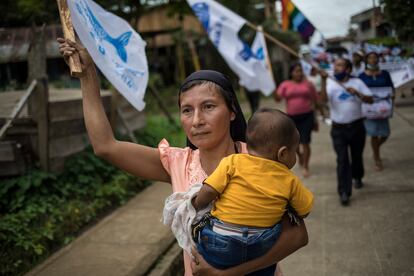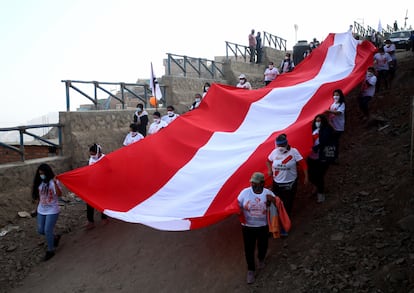If the 28 parties registered with the National Elections Board (JNE) were placed on the starting line in the 2026 elections, there would not be an athletic track with enough lanes to support everyone. There are still two years to go until the next political contest in Peru, but the main obstacle that citizens will encounter is already clearly visible: an immeasurable offer of options that does not necessarily guarantee representation and that will divide the votes even further.
The most recent survey by the Peruvian Institute of Studies (IEP) is revealing: if the elections were brought forward, 82.4% of Peruvians would not know which candidate or party to vote for. A widespread indecision that shows the discredit inspired by the political class and at the same time marks a contradiction: there is much to choose from, but it is not enough. None of the possible candidates even reaches 5% and the political group that received the most support, Acción Popular, registers a miserable 0.6%.
In addition to these twenty-eight parties, there are another nineteen in the process of entering the Registry of Political Organizations (ROP). If they succeed, if the call to the polls were today, forty-seven groups would appear on the electoral ballot. More than one ballot would require unrolling a papyrus. Certainly not all of them will compete for the presidency in 2026. Either because they did not come out unscathed from a blemish, they joined an alliance, last-minute disputes or because their only purpose is to obtain representation in Parliament.
For political scientist Omar Awapara, general secretary of the civil association Transparencythe atomization of the political offer is the result of the weakness and collapse of the political party system in Peru. A diagnosis that political scientists have been highlighting for decades and that instead of being reversed, is getting worse. “They are not parties per se. Not in the original conception that their members lead a partisan life and dedicate themselves professionally to politics. It is rather a proliferation of mini nano-parties that with certain tricks manage to comply with the formal requirements, but that in practice are ventures that flourish in a favorable context for them,” he points out.
Until now, the record for the most contenders in an election belongs to the 2006 elections, where twenty political parties competed for the Presidency. That time, the leader of the Peruvian Aprista Party, Alan García, and the retired military officer, Ollanta Humala, went to the second round with 55% of valid votes between them. The most critical point occurred in the 2021 elections, in which eighteen candidates participated, and the vote was split to the minimum: between Pedro Castillo, a union teacher with little political experience, and Keiko Fujimori, Alberto Fujimori’s heiress, they obtained only 33% of valid votes, and that was enough for them to compete for the presidential sash, which Castillo ended up winning in the second round. The figure of the outsider or political adventurer was evident.
“Small candidates know that with ultra-fragmentation, the percentages to go to the second round are low. After 2021, many want to be the next Pedro Castillo. The elections end up being a raffle or a lottery, because you don’t need to have very solid party bases. If the Virgin comes to you, you can become the governing party. If you exceed 10% you are already competing, and in the second round, where you are forced to choose, the percentages are already inflated,” explains Enrique Patriau, political scientist and journalist for the newspaper La República.

One of the aspects that favors dispersion has been the elimination of a phantom reform: the Simultaneous and Mandatory Open Primary Elections (PASO), a fairly common mechanism in other countries in the region, where citizens have the possibility of choosing the candidate of their party, instead of having this chosen only by the militants or delegates of said group. The PASO were approved in Peru in 2019, however, they were never applied. First the pandemic was used as an excuse and then lack of time was claimed. In December 2023, Congress eliminated this measure with 74 votes in favor, 36 against and 12 abstentions. The PASO were intended to function as a filter to avoid the overflow of parties.
Omar Awapara believes that the increase in political groups election after election is a reflection of an informality that is transversal to Peruvian society. “It is more complex to give political representation to that which is at the antipodes of formality. It happens in transport, in health, in education, in those illegal economies that have probably financed some initiatives that have had greater penetration in the political system. All of this complicates the panorama. Added to this is the disaffection of the people, when they are the ones who have an important role in punishing the actions of the parties,” he comments.
The 2026 elections will mark the return of two long-standing political groups that regained their registration: the Peruvian Aprista Party, which last May turned 100 years old and governed for two terms, and the Popular Christian Party, with 58 years of tradition. There will also be incursions by the radical Antauro Humala with a party that bears his initials: National Alliance of Workers, Farmers, University Students, Reservists and Workers (ANTAURO); and the businessman Carlos Añaños, founder of Grupo Aje, the successful beverage brand, who formalized his registration in the new party Perú Moderno. This process could also mean the return to political life of Alberto Fujimori, released amid questions at the end of 2023, although it remains to be seen how. Last week he made public his affiliation with the party led by his daughter, Fuerza Popular, but the truth is that according to the Constitution no one convicted of a willful crime can run for elected office.
“Everything is very unpredictable. We have gone from a party system to a party market. It is a degeneration. It would have been ideal to have open primaries, because that way you eliminate parties, but Congress opposed it and this is the result. Collecting signatures is not the way either, because you can sign without any kind of commitment and then walk away,” explains Enrique Patriau. Currently, political parties that want to register with the National Elections Board need to gather the signatures of 3% of the citizens who voted in the last national elections. That is equivalent to 531,412 signatures. They do not need to be affiliated or militants, but simply adherents, that is, those who have no party affiliation with the group, but want to support it with their signature. The weakness of this mechanism is that it has given rise to a black market where signatures are bought. Another novelty of the 2026 elections will be the restoration of bicameralism in Parliament, although the development of its application is still pending. The last Constitution that adopted a chamber of deputies and a chamber of senators was that of 1979. On the other hand, July 16 is the deadline for registration for parties with ambitions to govern. Everything points to a sadly famous record being set. There are already almost thirty, it could be almost fifty. Follow all the information from El PAÍS América on Facebook and Xor in our weekly newsletter.
#vote #Peru #parties #undecided